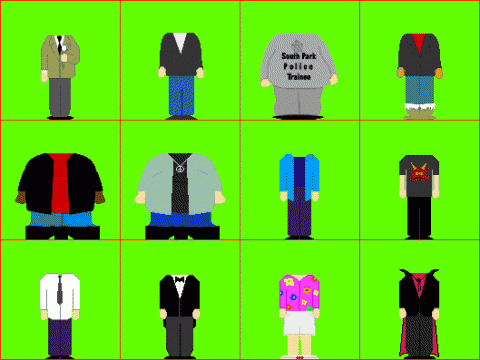South Park Avatar Guidelines

The World of South Park was a literal interpretation of the hit television series from Comedy Central. Designed and moderated by As If Productions, this unique chat site used The Palace software to take participants inside the wacky universe of Cartman, Kenny, Kyle and Stan, America's favorite foul-mouthed eight-year-olds. The site featured a large assortment of avatars and props drawn in the trademark South Park style, enabling citizens of the online world to create their own unique characters by assembling heads, bodies, clothing and other accessories from our collection.
This page explains how those avatars were made, featuring tips for Palace Avatar use. Even if you're not a user of The Palace software, these tips can come in handy for creating your own SouthPark-style characters. Enjoy!
The Palace Palette
All Palace art (avatars included) is represented in a specific 256-color palette called "the M&M Palette". The M&M Palette is available for download here:
Body Templates
South Park props were designed to be as mixable and matchable as possible, allowing users to create thousands of unique combinations. Therefore, the official South Park avatars were be based upon standard body types, or templates. The standard body fits within a 44-by-132 pixel space, allowing a full person to be represented by 3 props. The two most common body types for avatars in South Park were the "Tod Body" and the "Ellen Body". The templates for both these body types are shown below:


Tod Body
Ellen Body
Heads
Here are some sample South Park style heads.
Clothing Templates
Here are the templates for various types of basic clothing: Shoulders begin 37 pixels from the top. Therefore it takes 2 props to make a shirt. Females may have a little bit of neck showing. Pants begin 73 pixels from the top. May start higher but not lower. To meet the top of the pants, shirts must come down to at least 72. More is fine. The body templates show you the narrowest you can go for the width of clothing, but you can definitely go wider. Some Basic Female Clothing Some Basic Male Clothing


The Nametag Zone
(Non-Palace Users can ignore this part) You want to avoid doing anything significant in the area that will be covered by the user's Palace nametag. The default "Nametag Zone" runs from the 76 pixel mark to the 92, as shown below: The Nametag Zone

Skin
Due to the limitations of the M&M Palette, there are no perfect choices for a lot of real-life skin tones. Here are the indexes of the colors we used for the South Park style:


Skin Tones in the M&M Palette
NOTE: You can view the index number of a color by opening the palette and clicking on the color in question. In Paintshop Pro, you can view a color's number by holding the eyedropper tool over the color and looking at the Color Palette.
Style Tips
It is important to remember at all times that the goal of the site was to bring people inside the world of South Park, as close as possible to the one on their TV screens. For this reason, not all art submitted was accepted to the collection. The following tips were kept in mind: The goal is to look as much as possible like the "paper world" of South Park. Solid colors should be used practically everywhere. Dithering should be very rare and gradations are totally out of the question. There may be occassional use of dithered photorealistic images (Trey Parker's face on a T-shirt, for instance), as long as the spirit and humor of the prop fits in with the South Park style. There should be no traplines (i.e., black borderlines). South Park is not supposed to look like an illustration; the idea is to simulate the look of a cut piece of construction paper. Therefore, the only kind of trapline you can get away with is the shadow at the edge of the paper. This line should be of the same hue but a darker shade of the furthest-back color it borders on. For instance: a blue tie on a green shirt may be made to "pop out" by putting a slightly darker green trapline around it or along one side. Experiment with slightly differing shades until you get the right look. In general, brighter colors seem to "pop out" more than flatter and darker colors. You can use this effect to create a sense of depth between differently-colored areas. Some people prefer to start by drawing the characters in black and white with traplines, and then fill in the white areas with color. If this is your approach, use the color replacer tool when you're finished, and change the black lines to be just a hair darker than the color they border (or remove them completely by making them exactly the same as the color they border).
Sample Props, Avatars and Templates by:
Amy Bailey
Tod Foley
Jack Mingo
and The AIP Staff
Now that you're done with this tutorial,
Click Here for the South Park Character Creator!
This page is copyright © 1999-2007 As If Productions.
SPTV and South Park are products of Comedy Central.



